
*This article was originally published in Confidencial’s English Version
Suppose that one day the Police pull up in front of your house and install a barrier a meter and a half high to keep you from crossing the street. Your electricity comes from the other side, and so it’s cut off. Suppose that a group of police are guarding this barrier day and night so that no one crosses. That it’s illegal to cross over to “the other side” where the shops, the schools your children attend, and the clinic where you go are located, and where, for years, you’ve earned your living.
What would you do for work, to live, for food?
This isn’t a rhetorical question. On May 29, a group of Costa Rican police installed a metal barrier to block passage between Costa Rica and Nicaragua at the point known as El Cruce de la Trocha. On the other side of the barrier, at least 100 Nicaraguan families were left fenced in. Up until that moment, these families had closer relations with the Costa Rican canton of Los Chiles than with the Nicaraguan department of Rio San Juan, which they officially belong to.
Their stories form part of “The Drawn Border”, a binational project carried out by La Voz de Guanacaste; the Interferencia Radio network from the University of Costa Rica; and Confidencial in Nicaragua. In this, the second part, we examine a stretch of border in the Costa Rican canton of El Chile, where COVID-19 has redefined legality and everyday life for those families that built a life around the agricultural activities across the border.
El Triunfo
Yessenia Barraza is waiting for us in front of her small parcel of land in Costa Rica. She says goodbye to her daughters and nieces, who wait in the front room of the house for customers to appear at “Los Barraza”, the small shop where they sell rice, beans, bread, candy and soda pop. A transparent sheet of plastic has been stretched over the counter to protect them from the Coronavirus.
To reach Yessenia’s house from the town of Los Chiles, you have to make a five-mile detour over a gravel road surrounded by planted fields. The shop itself is located in a community called “Medio Queso” [Half Cheese], comprised “half and half” of Nicaraguans and Costa Ricans. The border itself lies some 12.4 miles to the north. Yessenia will accompany us on our route.
The sector where she lives is called El Triunfo, [The Triumph]. The name is no coincidence: in 2011, she and a group of 300 families entered a property of about 1.54 square miles that they assumed had been abandoned by an orange growing company. However, a businessman from the area claimed the property and violently evicted them seven times over the course of the next two years.
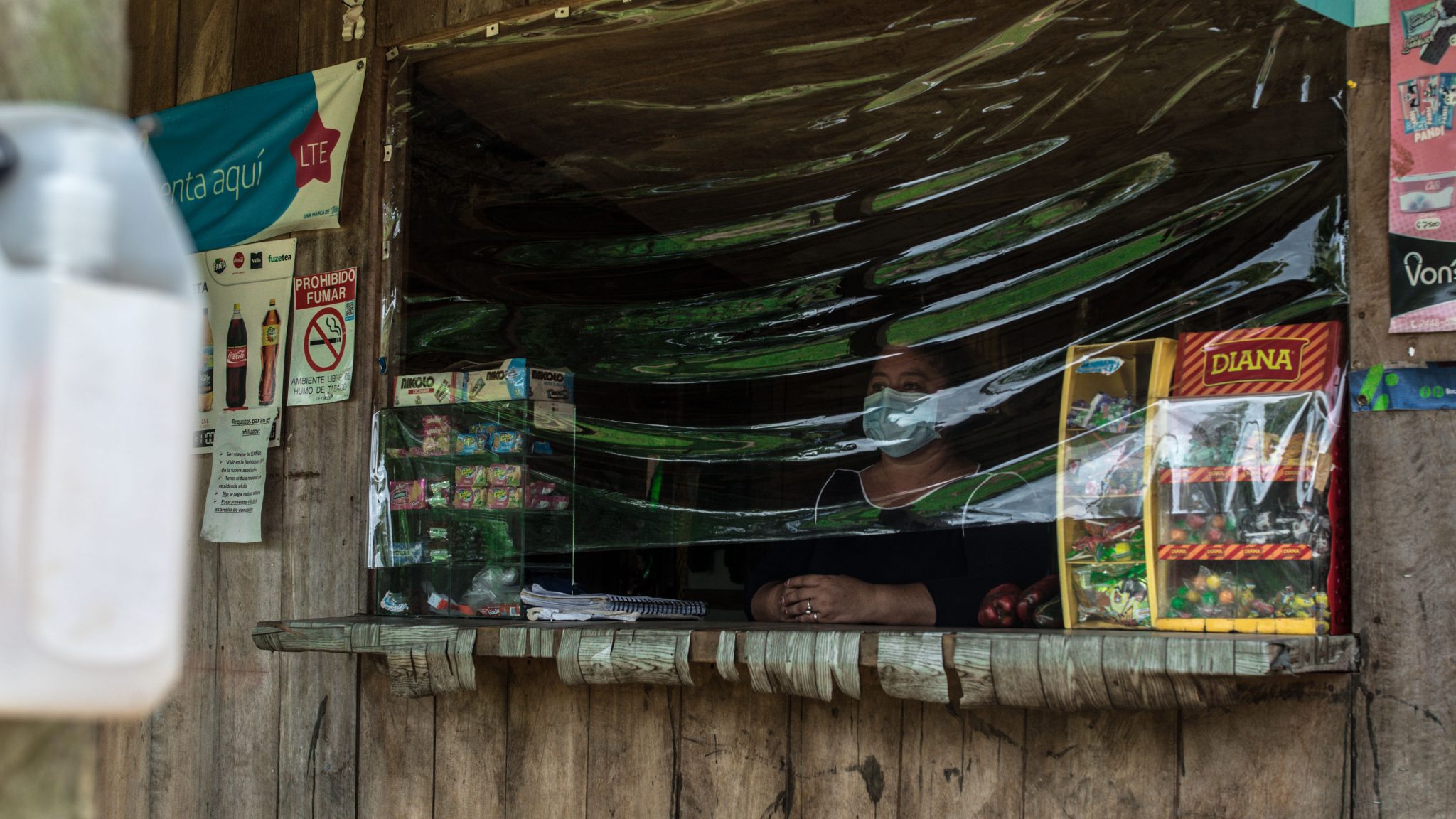
Yessenia Barraza, community leader, manages her shop in the rural settlement of “El Triunfo” part of the community known as “Medio Queso”. Photo: Sebastian Avendano.
Yessenia explains that their group kept fighting for those lands until finally the Costa Rican Agrarian Development Institute purchased them in 2014. A hundred of the families succeeded in obtaining a title allowing them to use the property.
Yessenia tells us all this while we plow forward along the muddy track that leads to the road known as La Trocha [the path]. As we approach the border, there are more and more fields of pineapples and groves of orange trees dominating the landscape. Yessenia tells us that when she arrived from Nicaragua in 2001, there weren’t as many plantations as there are now. No fruits were being cultivated. The small farmers of the canton sustained themselves by cultivating yucca and other tubers.
The pineapples and oranges took over the landscape “back around 2015”, recalls Yessenia. Now, the expansion of these monocultures has reached “the very border with Nicaragua.” The increased production attracted Nicaraguans to the labor force and tightened the ties between the communities on one side of the border and the other.
It’s not just a matter of work, she says. Before COVID-19, people came and went with no problem. The government even allowed it. The division between the two countries was just a path that people were used to crossing.
We’re speaking here of “The Path”, the controversial Route #1856 that was promoted by the government of Costa Rican president Laura Chinchilla at the end of 2015. The project’s objective was to mark off the border and create land access to Costa Rica’s northern zone following the Nicaraguan invasion of Calero Island. Two years later, the now ex-president was demanding an investigation of the irregularities supposedly committed during the construction of the nearly 100 miles of border highway. That’s how a highway that had cost some US $34 million dollars was left abandoned.
Now the road is an impossible sea of mud, but the communities are used to it. They continue coexisting with one more forgotten project.
The closing of the borders due to the pandemic has changed everything; community life, work, the food supply Yessenia feels that the government shouldn’t just close the borders, because many families on the other side depend on that connection to support themselves.
“They’re people who for their whole lives, since those companies began, have worked there. Their families depend on the salary that they earn, and when all of this happened, those people were left with no way to eat. Now, their families don’t know what to do,” she laments. While minimum wage in the Nicaraguan agricultural sector is about US $124 dollars a month, in Costa Rica it goes up to US $438.
“People say that we Nicaraguans are dumb, that we put up with anything, but it’s not like that. People do it because they have necessities, and the company owners take advantage of that,” she adds.
The open gate
The sound of tractors no longer awakens Antonio Monico Rivera at 2 am every morning. Up until a few weeks ago, the agricultural companies would send up to six small tractors every morning to transport the undocumented workers from Nicaraguan side.
Antonio has lived here for four years, at a point along the border known as Aguas Claras. He earns his living as a day laborer, planting fields, harvesting corn and beans and clearing the land. We found him feeding his chickens.
“A lot of people used to pass by,” he recalls, leaning against a wooden beam. “The tractor cars would be full. The companies would send for everyone to harvest the pineapples and pick the oranges too.”
Antonio has a grey beard and an open shirt that reveals his drooping chest, the skin sunburnt. Yessenia leads us to his house, which sits on a small parcel of land surrounded by plantations overgrown with weeds. It’s the only house for miles around.
“On the other side is Nicaragua,” says Antonio. Indeed, a few steps from here there’s a rusty gate, surrounded by weeds, which is always open. Up until a short while ago, it was an illegal crossing, where Nicaraguans could pass from one side of the border to the other without going through any of the official border posts.
The ruts left by the tractor wheels can still be seen on the road. As far down as we can see, the track is lost among the trees and brush that grow in the Nicaraguan territory.
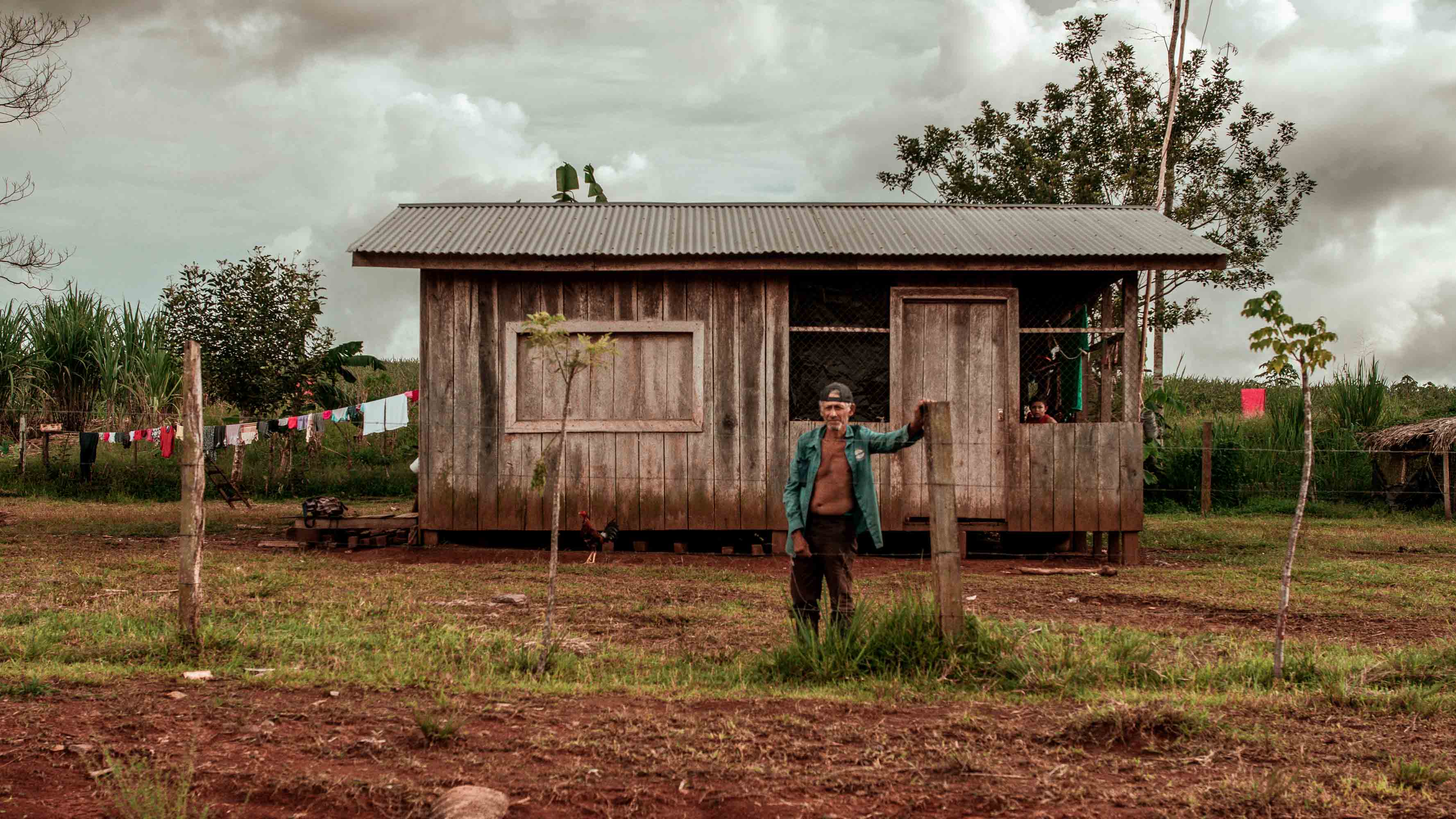
Before the pandemic, every day the “grasshoppers, as the small tractors are called, would come to the gate in front of Antonio Rivera’s house. That’s where they picked up the Nicaraguan migrant workers who labored in the agricultural fields of the “Los Chiles” canton. Photo: Sebastian Avendano.
Yessenia has spent years walking the streets of Los Chiles, fighting for the land in Medio Queso but also supporting the rights of the agricultural workers, especially the undocumented ones. For that reason, she wants us to go up to the gate through which, in pre-COVID times, the migrants entered Costa Rica every day. She sees this gate as the beginning of many of the violations of their rights.
Before the pandemic, the undocumented workers entered the country not only through this unmarked crossing, which the police call a “blind point”, but also through many others that are dispersed all along the border.
Up until a few months ago, the controls weren’t very strict. Jorge Castillo, the lieutenant in charge of the Los Chiles police command, would later tells us on the telephone that they were aware of “this type of vehicle”, meaning the tractors, or “grasshoppers” as Antonio calls them.
Residents we consulted coincide with the lieutenant in telling us that some agricultural plantation owners have a method to detect if there are active police operatives. “They station a motorcyclist or a person on foot at a crossroads, and when they see the police vehicles go by, they send out a warning,” Castillo explains.
At any rate, he affirms, whenever the police find a worker without their documents, they’re removed from the country. However, this was never as frequent as it is now. With the closing of the borders, the country has expelled some 6,760 migrants working without permits in the area around the Tablillas post in Los Chiles alone. This has been part of the “Secure Borders” program of the Costa Rican Ministry of Public Safety.
On June 26, the authorities signed an executive decree to strengthen the border guard still further in the northern zone. The document orders the General Direction of Migration and Foreign Services to adopt the needed actions to reinforce control of entry into Costa Rican territory. Among such actions is opening as many police control posts as necessary along the border.
Despite this, the gate in front of Antonio’s house is still open. Even though the tractors no longer arrive to pick up workers, Nicaraguans continue crossing over, “to get themselves a pineapple or two for making a fruit drink. That’s all,” Antonio says.
The railing
Ten minutes along the path from Antonio’s house, we encounter a metallic structure that blocks the way to the Nicaraguan community known as the Cruce de la Trocha. Yessenia has led us here so we can see how people’s lives have changed due to COVID-19, and also due to something stronger: the police presence.
The barrier that blocks off passage is a kind of railing that the police set up here on May 29 and that keeps vehicles and people from crossing over from one community to the other. The neighbors, accustomed to coming and going daily between Nicaragua and Costa Rica, feel that this is like being locked in.
“Here, we’ve always lived like a little island, leaning against the country that’s here, and where we were favored,” says a resident of the community, who preferred to remain unidentified.
But it’s not only the feeling of being trapped that is wearing on people; the barrier also has had other direct effects on their lives. For example, Costa Rica supplied their electricity, and it was cut off. Also, the other side is where they work, and now they can’t go. For these people, COVID didn’t bring a “new normal”, but a new illegality.
The ten families who live right on the border with Costa Rica, were connected to the electricity lines from there. Because of that access, the stores were situated right on the border. The rest of the houses also drew their electricity from there. Now left in the dark, these locales and families, lost the products that have to be kept refrigerated – meats, milk, cold cuts – except for what they could use or sell before they “lowered the switch” on the other side. Now, no one on the Nicaraguan side sells ice or refrigerated drinks.
The Electricity Administration department of the Costa Rican Electricity Institute in San Jose alleges that they’re not authorized to sell electric power in Nicaragua. However, he asserts that they never suspended electric service to the zone. Rather, he affirmed, they’re carrying out a study in the northern border region to identify “mechanisms and responsibilities for the possible illegal resale of electricity.”
Yessenia is sorry that the railing has damaged relationships between the border communities. “Everyone here gets along well. There hasn’t been a bad relationship until now, with this,” she complains.
The trucks with Costa Rican products that traveled from Los Chiles to stock the small stores on the Nicaraguan side no longer arrive either.
“Neither the vegetable seller who came, the cooking gas vendor, nor the chicken salesman. They never returned. And you can’t cross over either, if you ask permission to go there, they say no, because it’s forbidden. They don’t even let you go to the store,” states a neighbor from the other side of the barrier.
Given the shortage of food, some residents have to walk to the San Juan river to try their luck fishing. “Things are very tough, really hard. There are some families that are doing worse than we are,” a Nicaraguan woman complained. “We made a wood stove for cooking,” she added.
It’s a half-hour walk to reach the San Juan river; from there, they have to travel another two hours down-river in a motorboat if they want to get to the closest Nicaraguan town to buy something.
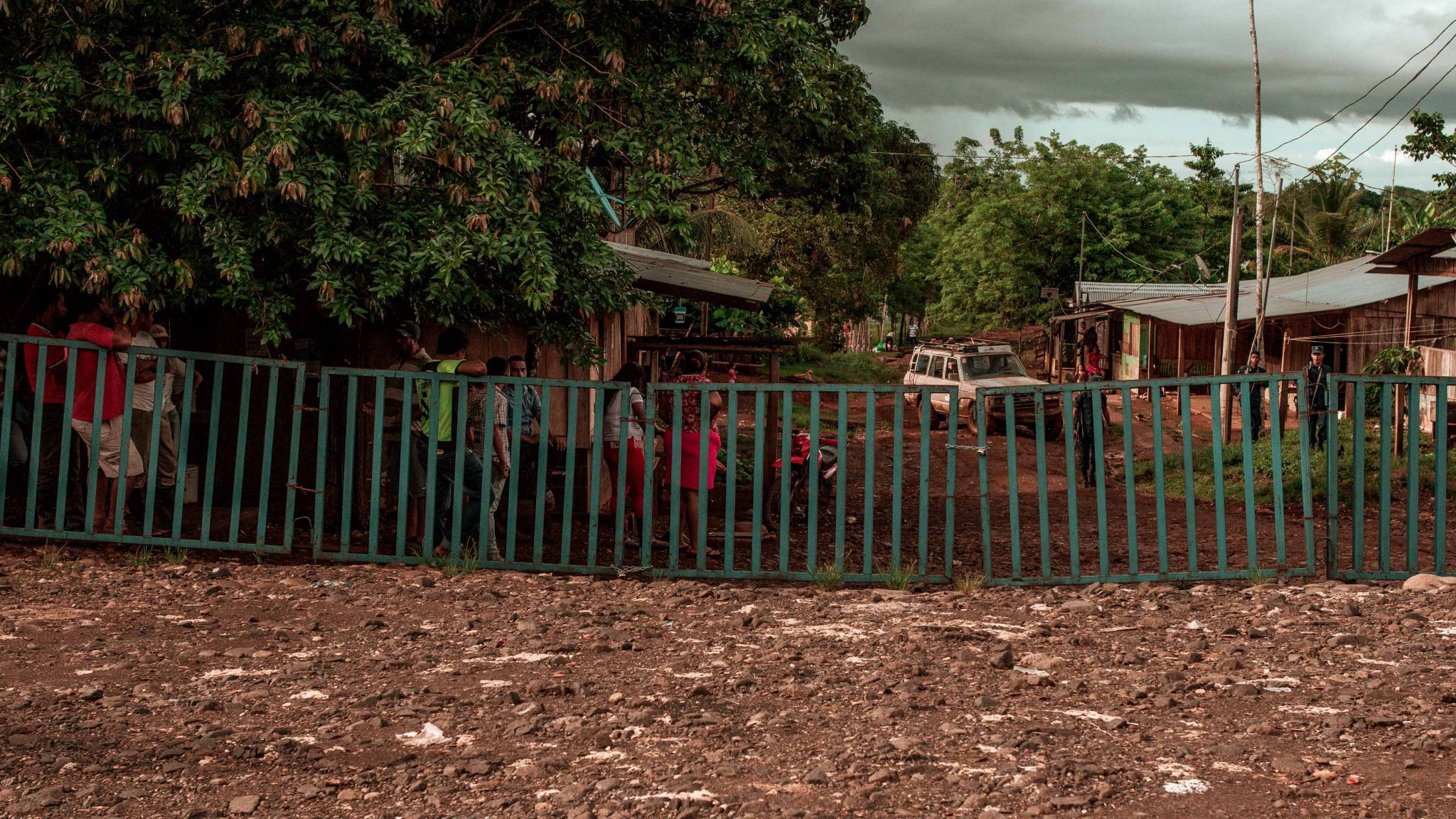
On May 29, a group of Costa Rican police installed a railing that blocks passage to Nicaragua at the point known as “El Cruce de la Trocha”. On the other side of the barrier, at least 100 Nicaraguan families are surviving the pandemic without medical attention, electricity or any options for working. Photo: Sebastian Avendano
This is what Luis Munoz explains to us from the other side of the barrier. Luis is a Nicaraguan who has lived here for the past 16 years.
The problem for them isn’t the distance as much as the price of the transportation. To navigate on the San Juan River, every trip costs at least 150 Nicaraguan cordobas, about US $4.35. But without work, any price is unaffordable.
“We’re worried about this, because every day our family economy is deteriorating. We’re getting to the end of the few coins we had saved,” says Rene Castro, a day laborer on the border plantations. “For over a month now, I’ve been unable to cross over to go to work.”
Castro says that his boss is now only giving work to people with documents, because they “tightened the screws”. The effect of that measure is that hundreds of Nicaraguans can’t come over to work as they used to, “because of the persecution from immigration”, says Castro. “There are hundreds of workers at home, doing nothing.”
The number is probably not hundreds, but thousands. According to information released by the Ministry of Agriculture and Cattle Raising (MAG) nearly a month ago, the national agricultural properties are in need of some 74,000 farmhands. This is a labor force that Costa Rica can’t supply.
Vice Minister of Labor Ricardo Marin later tells us that the MAG is working with the Immigration office on a decree to allow the entry of these cross-border workers. The decree in process would allow employees who certify that they have a contract in Costa Rica to obtain a “safe conduct” pass to enter the country.
It’s an agreement similar to the one that already exists in Panama for the entry of the indigenous population that works on the banana plantations in the south and Caribbean zones of Costa Rica. The workers must present a medical clearance and their temperature will be taken to verify that they’re not showing symptoms of COVID-19.
“But honestly, I’d be lying to you if I told you that there’s an agreement with Nicaragua now. It’s been very difficult, because that coordination doesn’t exist,” Marini explains.
To Luis, though, what all this brings is frustration. “We’ve never done any harm, other than help to plant those pineapples, to pick coffee or oranges,” he says. “That’s the ‘damage’ that we’ve done to Costa Rica – helping them raise production. Now, in return for that favor, we get this. It’s very tough.”
El Bochinche
The names of the towns along the border line are picturesque, to say the least. The next point on our tour is El Bochinche [The Ruckus], a Costa Rican village that sits at the edge of the road. It’s called that, Yessenia says, because its people are “known for their feistiness”.
Yessenia has brought us here because the majority of the inhabitants of this sector are dependent on the agricultural activity to work, and many of them have to travel to other communities. She says that with the pandemic came many things that “she doesn’t understand” or that don’t seem right to her, like the fact that those in El Bochinche can no longer travel in their vehicles with the same freedom as before.
Here we meet Carlos, who’s lived here for ten years. He’s Nicaraguan with Costa Rican residency, who works in a pineapple field in Medio Queso. Like nearly all the inhabitants of El Bochinche, he has to go out to the neighboring towns to get to work; now, though, he has to go “through the brush”, as he calls the small roads between the orange groves. With the increased police presence, the inhabitants’ fears of being detained have also grown. Carlos, for example, doesn’t have current papers for his car.
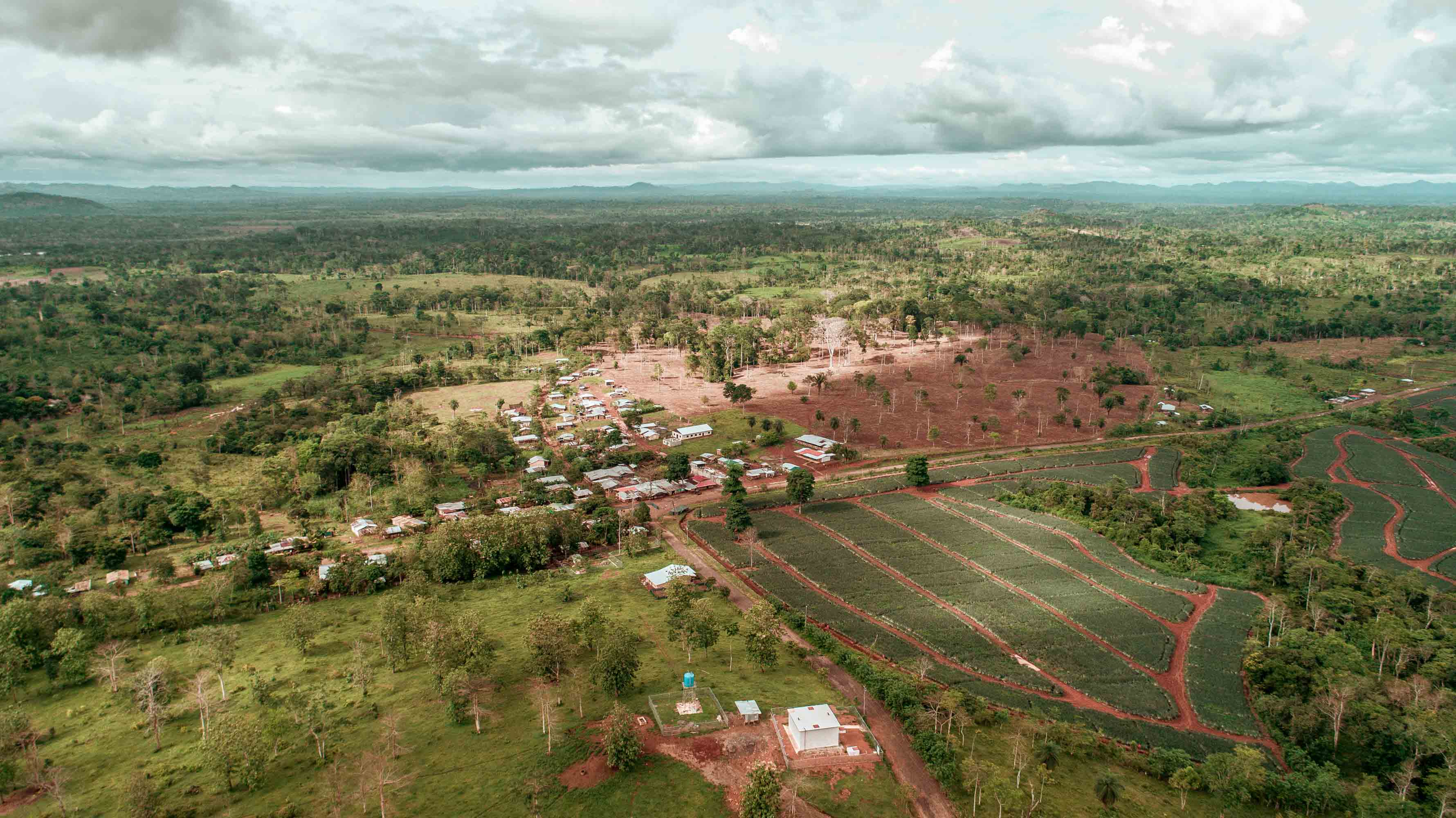
The border trail cuts the last kilometers of the country sown with orange. The border is behind the houses in this community. // Photo: Sebastián Avendaño.
That’s the norm along the border. Here, the vehicles are used along roads of slag and dirt – dusty in the dry season and slippery in the rainy season. Very few vehicle owners concern themselves with the obligatory mechanical inspections, licenses, or permits. Carlos says that before COVID-19, they could pass through the police checkpoints “with no fear”, because “they wouldn’t say anything”.
The orange groves on one side of the path trace parallel lines with little alleys between them. Along those paths the Costa Ricans and the Nicaraguans evade the authorities in order to come and go. Amid the orange groves that stretch from El Bochinche to Medio Queso, in one of those entry points, we encounter Jaime.
The brakes had frozen on the motorcycle he uses, so he stopped on one side of the road to try and fix it. We’d been looking for him for two days, but he was never home. Since Yessenia recognizes him, we get out to greet him.
He’s in a hurry, because he knows that the police operations in the zone have increased in the last weeks. “Now, you have to go about like the cats do, keeping under cover on all sides and checking if the patrols are around,” Jaime tells us. “Sometimes they’ll do you a favor and turn a blind eye,” he adds.
Jaime is Costa Rican, but like Carlos, he’s afraid he could lose his motorcycle if the police stop him, because his papers aren’t current; his salary won’t stretch that far.
Jaime is a crew boss on an orange plantation. What worries him most is the lack of Nicaraguan workers, because without them the company can’t function. And if the company can’t function, he’ll be left without the job he needs to support his wife and daughter.
“We had an excellent crew,” he says. However, 60 of the plantation workers had to leave because they didn’t have their immigration papers in order.
The interventions of the authorities (Public Safety, Ministry of Health, Ministry of Labor) in the northern zone of Costa Rica have resulted in the closure of 23 companies for violating public health orders. Another 57 received a public health citation, and 28 others had labor irregularities. In just one company, there were 21 workers already infected with the virus.
On the farm where Jaime works, there are still a few months left before the next orange harvest, and that’s something he’s grateful for. He hopes that by then the migrant workers will be allowed to get to the plantations.
For now, he just has to wait and hope for that opening, since the health authorities have only announced that the international airports will be able to receive tourists beginning in August.
“Sincerely, if it weren’t for the Nicaraguans here, Costa Rica would go under, because no Costa Rican would do the work that the Nicaraguans do,” he adds.
Jaime’s motorcycle starts up, and he’s on his way, with the fear of losing it if they stop him. Because of that, he says he doesn’t use it much. “Today, I was just doing an errand nearby.”
The pandemic
On the second day of our trip to Los Chiles, Yessenia takes us to meet her sister-in-law Sandra in the hamlet of Santa Fe, another of the communities whose inhabitants make their living from the agricultural fields. We had established that she would take us through the community, but she has some news for us: they informed her yesterday that her son had tested positive for COVID-19.
The 18-year-old is one of the first cases in the zone. He only began working in the local pineapple plantation a month and a half ago. He had gone to look for work there, and they hired him, given the scarcity of hands due to the border closure.
A worker at the same field was infected, and that’s where the young man picked up the virus. “My son didn’t tell me anything about the talk that was going around about the pineapple fields, that you come out of it with COVID-19,” Sandra tells us, notably fatigued.
“He went there (to the hospital) for a bite he got in the pineapple fields, that had infected his hand. He went for that, but then they tested him and he came out [positive]. He had no symptoms,” she says.
Sandra’s worried about the discrimination the family could suffer and asks us not to take any pictures of her face. Yessenia talks with the other women there, while we interview her sister-in-law. They insist that – unfortunately – the protective measures didn’t reach the plantations until a lot of “noise” was made on the topic. “Otherwise, there wouldn’t have been any infections,” Yessenia says.
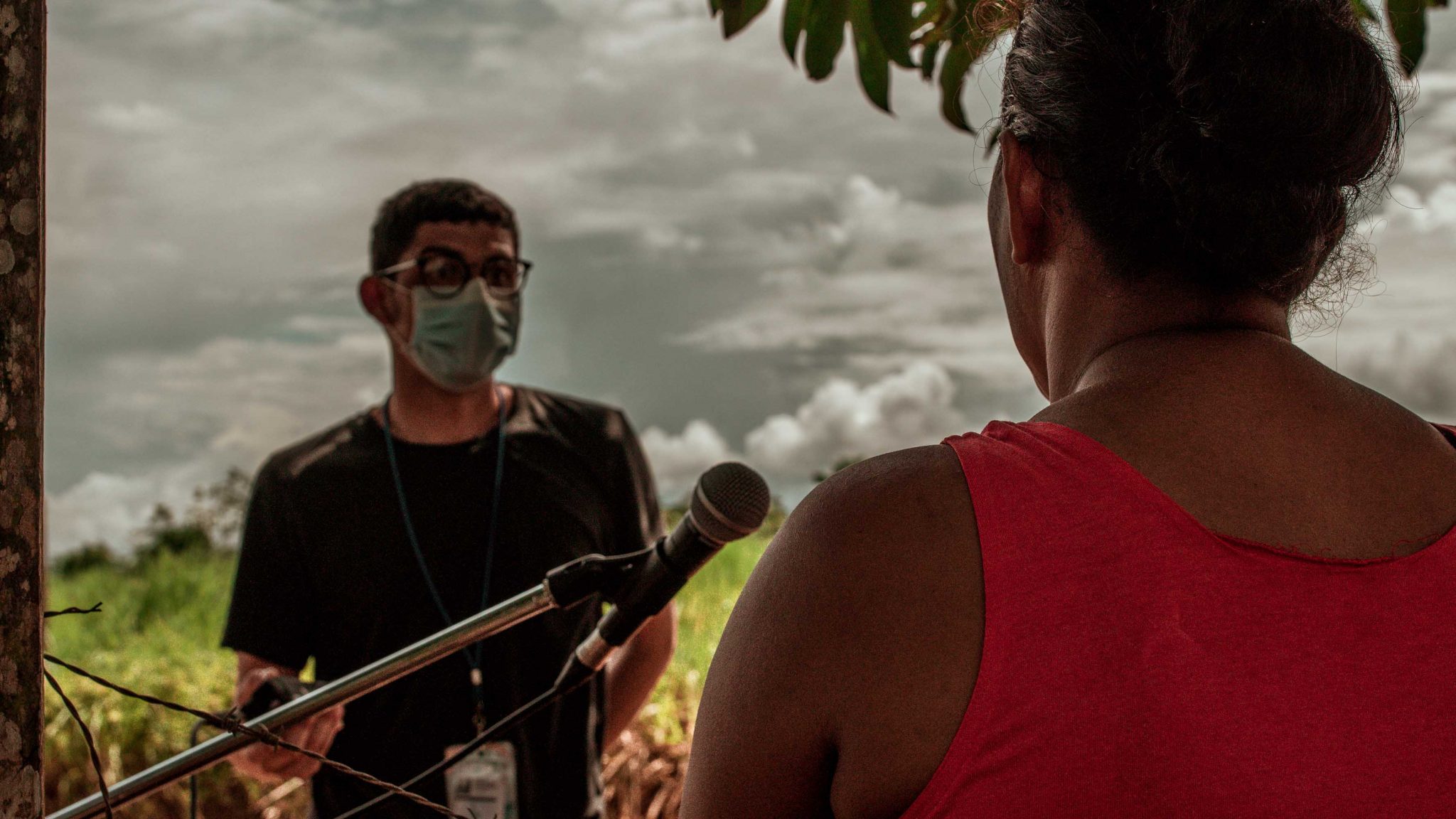
Sandra opted not to show her face because she fears discrimination. Her son tested positive for COVID-19 at the hospital in “Los Chiles” on June 15. The 18-year-old had been working in the pineapple fields in the nearby community of Santa Fe, for only a month and a half. Photo: Salvador Avendano.
Another thing that worries Sandra is how to isolate him, because there are six people living in their three-room house, including one of her daughters-in-law. “We don’t have a space for just him. I don’t have it. We don’t know how we’re going to take that measure now that the [Health] Ministry will be coming.
Of the six people that live there, only two are working, and so the worry is ever greater. For now, they’ll be left without one of the incomes. Before, they were barely getting by day-to-day, and “we don’t know if they’re going to give him anything,” Sandra adds, referring to some kind of pay from the company her son was working for.
***
We leave Yessenia back on her parcel, after our tour of the communities. Before we go, we buy a few drinks in the store, as a way of not leaving El Triunfo empty-handed.
By June 16, the number of positive COVID-19 cases in Los Chiles had grown to 14. Sandra’s son is one of them. The number continued rising, however, until by July 6 there were 65 active cases in the canton.
One of them is a person we know well, Ten days after our tour of the border communities, Yessenia sent a message to the reporter who accompanied her on that circuit.
“I wanted to tell you that, unfortunately, I tested positive for COVID-19. The whole family, even my sister and the little ones. “You should see how tough it is.” A total of 14 people fell ill in Yessenia’s family. The first of them, her husband, also worked in the fields.
***

“The Drawn Border” is a binational investigation carried out jointly by “La Voz de Guanacaste”, University of Costa Rica’s “Interferencia Radio” and Confidencial of Nicaragua.
*This story was reported by David Chavarría, written by David Chavarría and María Fernanda Cruz, and edited by Hulda Miranda, Gabriela Brenes, Cindy Regidor and Arlen Cerda. The photographs, video and video editing are by Sebastián Avendaño. The script of the video is by Cindy Regidor. Our assistant during the tour was Fernando Mora.


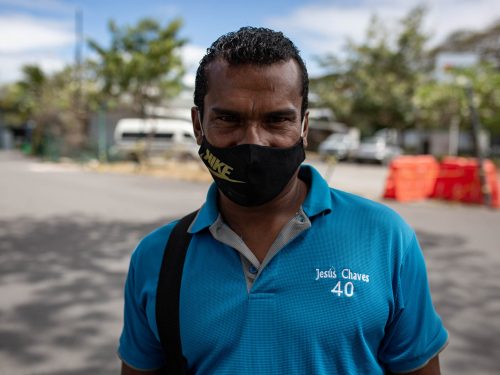
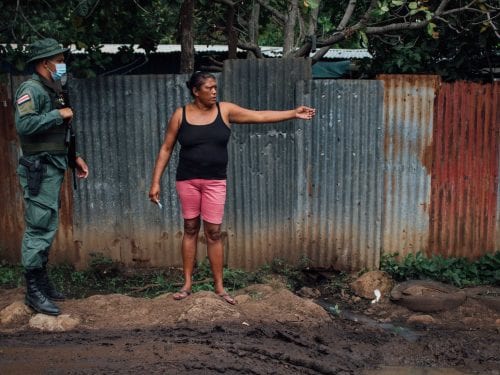
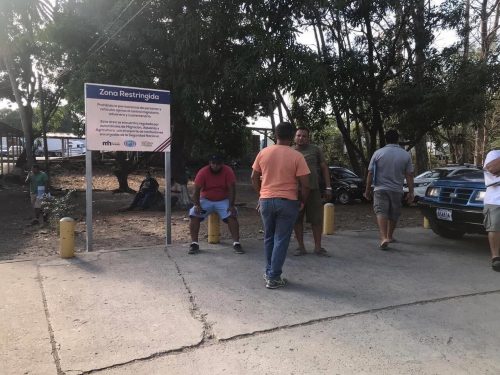

Comments